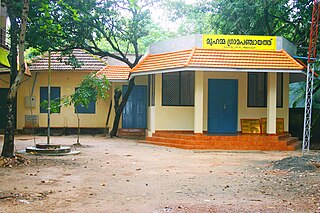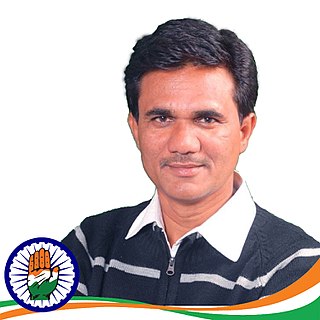Related Research Articles
Gram panchayat is a basic governing institution in Indian villages. It is a political institution, acting as cabinet of the village. The Gram sabha work as the general body of the Gram panchayat. The members of the Gram panchayat are elected directly by the people. The President of Gram Panchayat is called Pradhan or Sarpanch
A sarpanch, gram pradhan, mukhiya, or president is a decision-maker, elected by the village-level constitutional body of local self-government called the gram sabha, in India. The sarpanch, together with other elected panchayat members, constitute gram panchayats and zilla panchayats. The sarpanch is the focal point of contact between government officers and the village community and retains power for five years. the term used to refer to the sarpanch can vary across different states of India. Here are some of the commonly used terms for sarpanch in various states: panchayat president, gram pramukh, gram pradhan, gram adhyaksha, gaon panchayat president, gram panchayat president, etc.
Panchayat samiti or Block Panchayat is a rural local government (panchayat) body at the intermediate tehsil (taluka/mandal) or block level in India. It works for the villages of the tehsil that together are called a development block. It has been said to be the "panchayat of panchayats".

Panchayati Raj is the system of local self-government of villages in rural India as opposed to urban and suburban municipalities.
Local government. in Maharashtra State follows the general structure of Local Governance in India and is broadly classified into two categories: Urban Local Governance and Rural Local Governance.
The Ministry of Panchayati Raj is a branch of the Government of India. Ministry of Panchayati Raj looks into all matters relating to the Panchayati Raj and Panchayati Raj Institutions. It was created in May 2004. The ministry is headed by a minister of cabinet rank / Minister of State and transfers grants to rural local bodies for civic programs such as maintenance and construction of roads, pavements, bridges, drainage systems, parks, piped water supply, streetlights etc.
Kerala is a state on the southwestern coast of India. It is known for its high literacy rate, low infant mortality rate, and long life expectancy. Kerala has also been a pioneer in the field of decentralization and participatory local democracy.
Municipal or local governance refers to the third tier of governance in India, at the level of the municipality or urban local body.
A district planning committee (DPC) is the committee created as per article 243ZD of the Constitution of India at the district level for planning at the district and below. The committee in each district should consolidate the plans prepared by the Panchayats and the municipalities in the district and prepare a draft development plan for the district.
Local government in India refers to governmental jurisdictions below the level of the state. Local self-government means that residents in towns, villages and rural settlements are the people elect local councils and their heads authorising them to solve the important issues. India is a federal republic with three spheres of government: central, state and local. The 73rd and 74th constitutional amendments give recognition and protection to local governments and in addition each state has its own local government legislation. Since 1992, local government in India takes place in two very distinct forms. Urban localities, covered in the 74th amendment to the Constitution, have Nagar Palika but derive their powers from the individual state governments, while the powers of rural localities have been formalized under the panchayati raj system, under the 73rd amendment to the Constitution.
The Balwant Rai Mehta Committee was a committee originally appointed by the Government of India on 16 January 1957 to examine the working of the Community Development Programme and the National Extension Service and to suggest measures for their better working. The Chairman of this committee was Balwantrai G Mehta. The committee submitted its report on 24 November 1957 and recommended the establishment of the scheme of 'democratic decentralisation' which finally came to be known as Panchayati Raj. The main aim of Panchayat raj system is to settle the local problems locally and to make the people politically conscious.
Local bodies in Tamil Nadu constitute the three tier administration set-up in the South Indian state of Tamil Nadu. It is a system of local government which forms the last level from the Centre. Chennai Corporation in the then Madras Presidency, established in 1688, is the oldest such local body not only in India but also in any commonwealth nations outside United Kingdom.

There are 8 divisions and 64 districts in Bangladesh, each district further subdivided into upazila. The area within each subdistrict, except for those in metropolitan areas, is divided into several unions, with each union consisting of multiple villages. Direct elections are held for each union, electing a chairperson and a number of members. In 1997, a parliamentary act was passed to reserve three seats in every union for female candidates. Following elections in the 2014–16 period, 25.2% of councillors were women, up from 23.4% in the 2011–13 period.
The Zila Panchayat or District Development Council or Zilla Parishad or District Panchayat or Zilla Praja Parishad or Zila Parishad is the third tier of the Panchayati Raj system and functions at the district levels in all states. A Zila Parishad is an elected body. A District Panchayat is headed by a President, who is a elected member. Block Pramukh of Block Panchayat are also represented in Zila Parishad. The members of the State Legislature and the members of the Parliament of India are members of the Zila Parishad. The Zila parishad acts as the link between the state government and the village-level Gram Panchayat.

The Panchayat raj is a political system, originating from the Indian subcontinent, found mainly in India, Pakistan, Bangladesh, Sri Lanka, and Nepal. It is one of the oldest system of local government in the Indian subcontinent, and historical mentions date to the 250 CE period. The word raj means "rule" and panchayat means "assembly" (ayat) of five (panch). Traditionally, Panchayats consisted of wise and respected elders chosen and accepted by the local community. These assemblies settled disputes between both individuals and villages. However, there were varying forms of such assemblies.
Block Pramukh is a term used in India to refer to the elected head of a Panchayat Samiti or Block Panchayat. The Panchayat samiti is a tier of the Panchayati raj system. It is a rural local government body at the Tehsil (block) level in India. It works for the villages of the tehsil that together are called a development block. The Panchayat Samiti is the link between the gram panchayat and the zila parishad. There are a number of variations in the name of this institution in the various states. For example, it is known as Kshetra Panchayat in Uttar Pradesh, Mandal Parishad in Andhra Pradesh, Taluka Panchayat in Gujarat, Block Panchayat in Kerala, and Mandal Panchayat in Karnataka.

Harshawardhan Liladhar Nikose is an Indian politician member of Indian National Congress party and active mainly in Nagpur, Maharashtra region. He is state convener of Rajiv Gandhi Panchayat Raj Sanghatan and President of Indian national Congress Party, Nagpur district. having held previous offices of Chairman of Social Welfare committee, Zilla Parishad Nagpur (2007–10) and Sarpanch of Dorli village (2001-2005) in Parseoni Taluka of Nagpur District. Harshawardhan Nikose has appointed president of Vidarbha region, Rajiv Gandhi Panchayati Raj Sangathan in December 2018. New opportunity by All India Congress committee scheduled caste Dept as a Parliament co-ordinator of ramtek- 09 Parliament election 2019 under leadership development missions in reserve constituency.

The State Election Commission Uttar Pradesh, commonly known as the Uttar Pradesh State Election Commission, is an independent constitutional body responsible for conducting elections for urban and rural local bodies—the constitutionally mandated third-tier of government in India—in the Indian state of Uttar Pradesh (UP). The commission is headed by the Uttar Pradesh State Election Commissioner, at present, Manoj Kumar.
The 2018 Assam panchayat election were held in two phases, on 5 and 9 December 2018. The counting of votes started on 12 December and results were declared on 15 December. More than 15.6 million people were eligible to vote and voter turnout was over 78 per cent.

Committee on Panchayati Raj Institutions of Punjab Legislative Assembly is constituted annually for a one year period from among the members of the Assembly. This Committee consists of thirteen members.
References
- ↑ Debroy, Bibek; Pitambar Datta Kaushik (2005). Energising Rural Development Through 'Panchayats'. p. 81. ISBN 9788171884179 . Retrieved 26 February 2013.